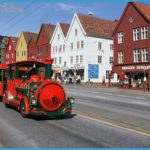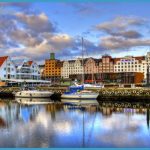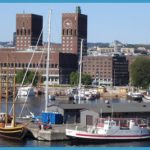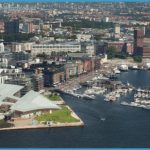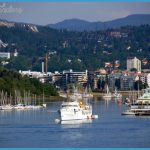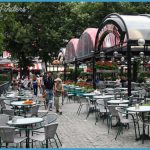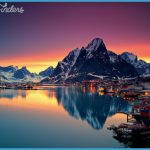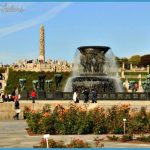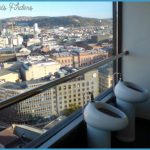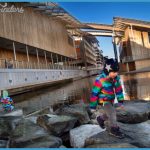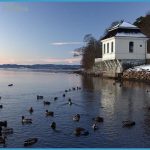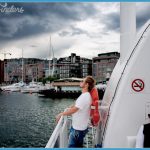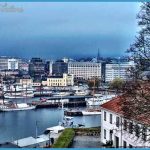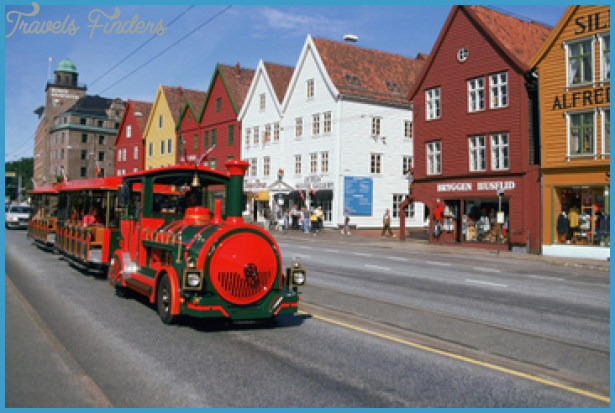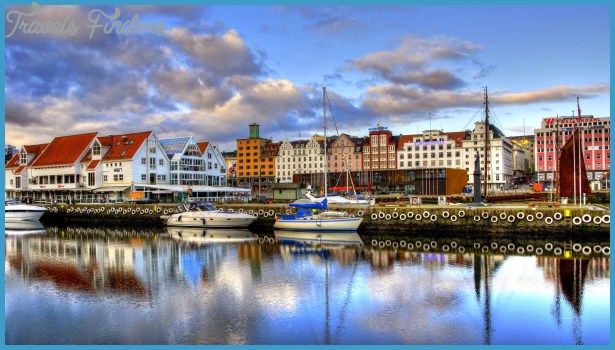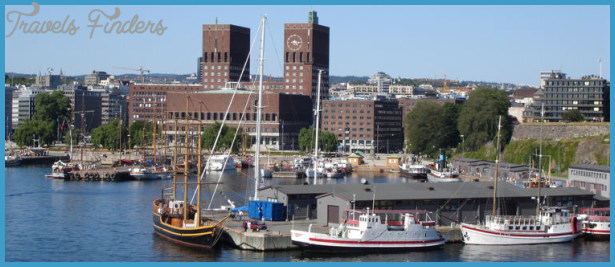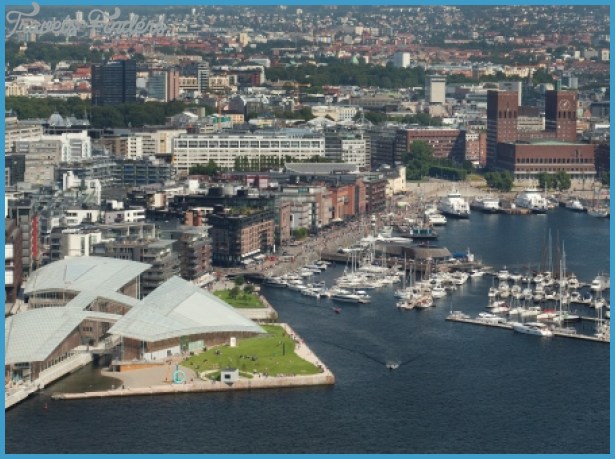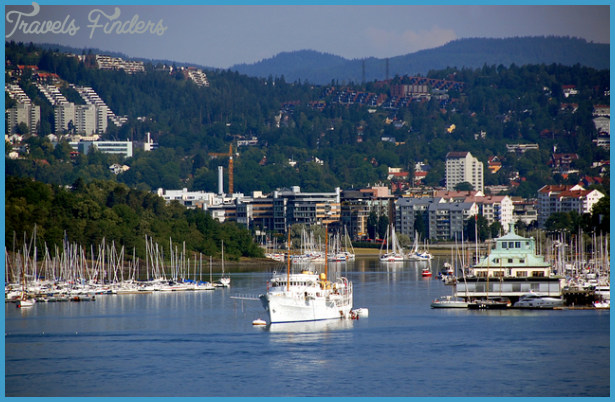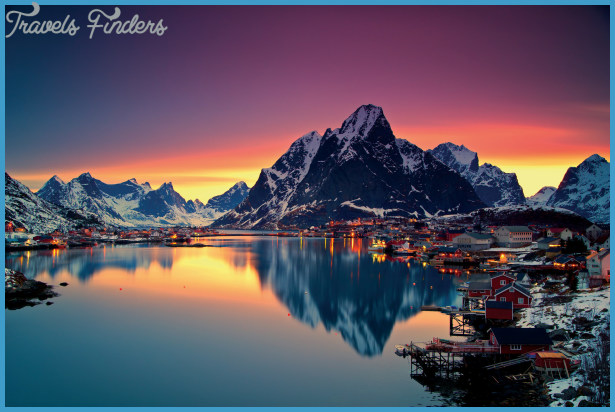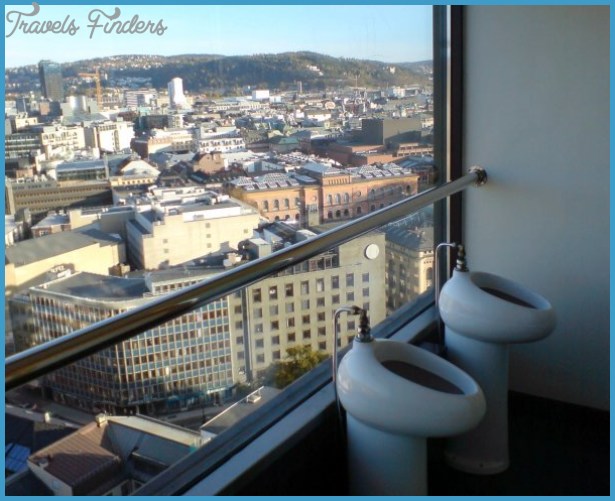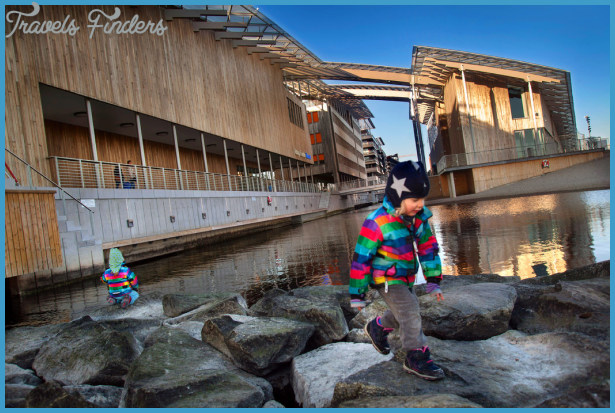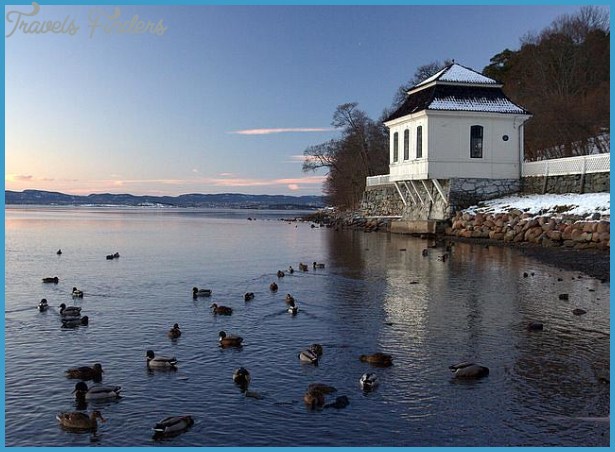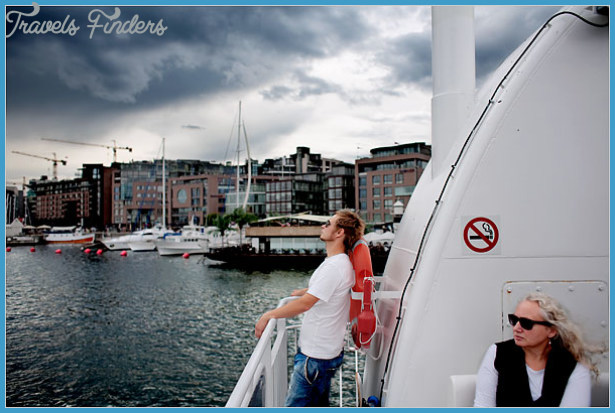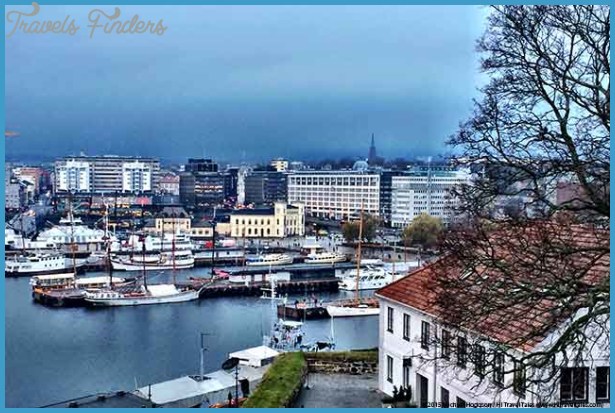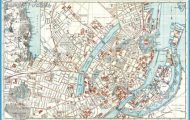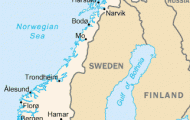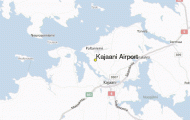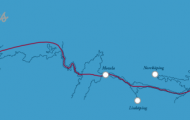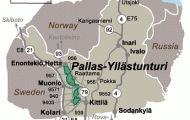Oslo’s main shopping and business street is the Karl Johansgate, which runs NW from the East Station (Ostbanestasjonen) to the Royal Palace. Half-way between the station and Eidsvollplass in the Stortorg, usually known simply as Torget, stands a statue of Christian IV (by C. L. Jacobsen, 1 874). The Cathedral (Dom-kirke), on the SE side of the square was consecrated in 1697, restored by the Hamburg architect A. de Chateauneuf in 1849-50 and internally renovated in
1948-50. The main entrance has bronze doors (1938); notable features of the interior are the ceiling paintings by H. L. Mohr (1936-50), the pulpit and altar (1699), the organ-case (1727) and the stained glass by E. Vigeland (1910-16). In the Chapel of Our Saviour, built
1949-50, is a fine silver sculpture by Arrigo Minerbi, The Last Supper.
Beyond two side streets leading to the Stortorg lies the busiest part of Karl Johansgate (many shops). On the farside of the intersection with Akersgate is the Parliament Building (Storting)’, in the Chamber hangs a large picture by 0. Wergeland of the constitutional assembly at Eidsvoll in 1 814. On the S side of the
Parliament Building is a monument to the poet J. H. Wessel (1 742-85), and opposite this the Freemasons’ Lodge. In the tree-lined Eidsvollplass adjoining the Parliament Building can be seen a statue of the poet, Henrik Wergeland, of Bergs-lien (1808-45). In No. 10, Rosenkrantz-gate, which crosses Karl Johansgate here, is the Oslo Nye Teater (plays, revues, etc) and to the NW of Eidsvollplass the National Theatre (Nasjonalteatret) (H. Bull, 1895-9). In front of the latter are bronze statues of Ibsen and Bjornson (by S. Sinding); behind it are a statue of the actor J. Brun and the entrance to an underground (subway) station (several lines, including the one to Holmenkollen). Diagonally across from the National Theatre is the Norske Teater (classical, modern and foreign plays). To the NE of the National Theatre, in the gardens on Karl Johansgate, stands a statue of the playwright Ludvig Holberg, a native of Bergen, who created the Danish-Norwegian comedy.
Just S ofthe National Theatre, in Fridtjof Nansens Plass, we come to the monumental Town Hall (Radhus: by Arnstein Arneberg and Magnus Poulson, 1931-50), one of the city’s great landmarks. (Fine interior, richly decorated with modern frescoes; 38-bell carillon in E tower.) Beyond the Town Hall is the quay from which motorboats leave for Bygdoy and other destinations in the Oslofjord. To the NE of the National Theatre, on the other side of Karl Johansgate, is the University (founded by Frederik VI of Denmark in 1811; present buildings, 1 839-54). In front of the central building are statues of the legal scholar, A. M. Schweigaard (1808-70: on left) and the historian P. A. Munch (1810-63: on right). The Great Hall in the rear building, which was added in 1911, boasts fine ‘murals by Edvard Munch (1 926). Most of the students from outside Oslo live in the University City in Sognsvei, on the N side of the town, a series of uniformly designed buildings used as hotels during the summer vacation. Distributed within these buildings is an extensive collection of works of art (Edvard Munch, Per Krohg, etc.). To the W of Sognsvei, in the Blindern district, are several new University buildings. In No. 13 Universitetsgate, which skirts the E side of the University, is the National Gallery (Nasjonalgalleriet: built 1879-81; extensions, 1907 and 1 924), which offers an excellent survey of Norwegian painting from the 19th c. to the present. It is particularly rich in works by J. C. Dahl (1788-1857), T. Fearnley (1802-42), H. F. Gude (1825-1903), H. 0. Heyerdahl (1857-1913), C. Krohg (1852-1925), G. P. Munthe (1849-1 929), E. Peterssen (1 852-1 928) and A. Tidemand (1814-76). A special room is devoted to Edvard Munch. There are also works by Danish and Swedish artists, pictures by Rubens, Rembrandt, Lucas Cranach, El Greco and other European masters, and a good collection of works by modern French artists (Cezanne, Degas, Gauguin, Manet, Matisse, Picasso, etc.). NW ofthe National Gallery in the Historical Museum (Historisk Museum’, entrance at No. 2 Frederiks-gate), are the University’s historical and ethnographic collections. Among the Nordic antiquities, the rich collection of material from the Viking age (c. 800-1 050) is particularly noteworthy. There is also a good collection of material on the Eskimo and Siberian peoples and also a collection of coins and medals.
At the NW end of Karl Johansgate, standing on higherground, in a large park, can be seen the Royal Palace (Det Kongelige Slott). It is a long, sober building erected between 1 825 and 1 848 (closed to the public). In front of the palace is an equestrian statue of Karl XIV Johan (B. Bergslien, 1875). Nearer Karl Johansgate is a striking monument to the mathematician, N. H. Abel (G. Vigeland) and beyond the palace, on the right, a bronze statue of the woman writer, Camilla Collet (1813-95), also by Vigeland. Along the S side of the palace grounds runs Drammensvei, and, at its intersection with Parkvei, on the right, is the Nobel Institute. The Nobel Peace Prize is presented annually, to a person selected by the Norwegian Storting (Parliament), in the Great Hall ofthe University. Tothe W, at the intersection of Drammensvei with Observatoriegate, the University Library (1913, with extensions of 1933 and 1945) houses 3 million volumes. From here Frognervei leads NW to the Frognerpark.
From the Parliament Building, Akersgate runs NE past the Oslo Tinghus (Council House, 1903) and the modern Government Buildings (1 957-9; at Nos. 42-44) to the Trinity Church (Trefoldighedskirke, 1853-58), which contains beautiful stained glass by F. Haavardsholm and one of the oldest organs in the country. Beyond this, to the E, are the Deichman Municipal Library (founded 1780; present building 1929), with about 850,000 volumes, and the Swedish Mar-garetakirke (1926). To the SE, in Youngs-torg or Nytorg, is the Norske Opera (Folketeatret, 1958), the city’s largest theatre (opera, ballet). At the N end of Akersgate stands St Olav’s Church (1853: R.C.), and opposite, at No. 1 St Olavsgate the Museum of Applied Art (Kunstindustrimuseet), which gives an excellent survey ofthe development of the applied and decorative arts in Norway (tapestries, including the fine Baldishol tapestry, c. 11 80, from Baldishol church in Hedemark; metal articles, glass, furniture, etc.). Associated with the Museum is a School of Arts and Crafts. To the N of the Museum, between UllevSlsvei and Akersvei, is the Cemetery of Our Saviour {Var Frelsers Gravlund). Near the middle can be seen the tomb of Bjornson, below is the grave of Ibsen, above, to the right those of the painter H. F. Gude and the poet Wergeland. At the N end of Akervei, on the right, is the Gamle Akers Kirke (Old Akers Church), an Anglo-Norman or basilican church which first appears in the records before 1150 and may have been founded by Olav Kyrre (restored 1861). To the N of the cemetery, by way of Ullevalsvei, is the beautiful park on St Hanshaugen.
In the old part of the town to the S of the Parliament Building and Karl Johansgate are the head offices of several large banks and business houses. To the SW of the East Station stands the Exchange (Bor-sen; built 1827, enlarged 1910). Farther W, in Bankplass, rises the massive granite building of Alorges Bank (1 904). To the W of this part of the town, rising above the Oslofjord, is Akershus Castle (building begun by Hakon V in the late 1 3th c.). The entrance, in Festningsplass, leads to the castle proper; visitors are shown a number of casemates (chambers built in the walls), various rooms and the chapel (tomb of King Hcikon VII, 1 872-1 957, in crypt). In the Resistance Museum (Hjemme-frontmuseum or Home Front Museum) are relics and souvenirs of the war years (1 940-5). In the old Arsenal, below, isthe new Norwegian Defence Museum, opened in 1978; when it is completed, it will trace the history of the defence of Norway from Viking times to the present.
To the NW ofthe town, reached by way of Drammensvei and Frognervei, is the beautiful Frognerpark (main entrance in Kirkevei; several restaurants; popular open-airswimming pool), with the Municipal Museum (Oslo Bymuseum) in an old manor-house. SW of the Museum, beyond Halvdan Svartesgate, is the workshop (now a museum) of the great Norwegian sculptor Gustav Vigeland (1869-1943); he created the principal feature of the Vigeland Sculpture Park. This is an extraordinary collection of sculpture, some 600 m (650 yds) long, which Vigeland, financed by the city of Oslo, worked on for 40 years. The Vigeland Bridge alone is flanked by 58 bronze groups. The oldest part of the complex is the fountain, depicting the cycle of human life. Beyond this is apillar 17 m (55 ft) high, carved rom a single piece of stone, with 121 intertwined human bodies; at the far end is a circular group, the Wheel of Life (1933-4). To the W, in front of the Colosseum cinema (F. Nansenveien 6), is a bronze statue of Charlie Chaplin (by Nils Aas, 1976).
On the E side of the town extends the Botanic Garden (Botanisk Have: entrance in Trondheimsveien), and on the hill above the garden are the Zoological Museum and the Museum of Mineralogy and Geology, with the Palaeontological Museum. On the S side of the Botanic Garden, at No. 53 Toyengate, is the
Munch Museum, with pictures, sketches and drawings (23,864 items) by Edvard Munch (1 863-1 944), Norway’s leading painter. Farther SE, at No. 1 Fyrstikkalle, is the Museum of Technology. SE of the station, at No. 13 Oslogate, stands Oslo Ladegarden, a Baroque mansion restored in 1957-68 (models of the old town, etc.).
SURROUNDINGS. 3 km (2 miles) S of the East Station is the Ekeberg, with the popular Ekeberg Park (riding school; restaurant) and the School of Seamanship (frescoes by Per Krohg inside). From here there is a beautiful view (particularly in the morning) over Oslo harbour. Between the School of Seamanship and Kongsveien is an area containing 5000-year-old stone carvings (helleristninger).
To the W of Oslo (6 km (4 miles) by road; motorboats from Rcidhusplass) is the Bygdoy peninsula, which offers a variety of attractions, particularly the Folk Museum and the Viking ships. The Norwegian Folk Museum (Norsk Folkemuseum) consists of a number of museum buildings containing collections of everyday objects, furniture (including Ibsen’s study), religious art and material from Lapland, together with the Old Town (Gamle Byen: old town houses) and an extensive open-air museum of old wooden buildings arranged under regions (particularly noteworthy items are the 12th c. stave church from Gol, brought here in 1885, and the Raulandstue from the Numedal, dating from about 1 300).
To the S of the Folk Museum is a large hall (Vikingskiphuset) specially built to house the Viking ships, three seaworthy 9th c. vessels, used by the Vikings on their long-distance voyages and also for the burial of their chieftains. The Oseberg Ship (21 50 m (70 ft) long and rather more than 5 m (16 ft) wide), the finest and richest pre-Christian find in the northern countries, was discovered N of Tonsberg in 1903. Built about 800 and used for a burial in the 9th c. it was a luxury vessel belonging to a chieftain’s wife, probably intended for short voyages. It is famous for the rich grave goods, known as the Oseberg collection, which were found in the ship. The Gokstad Ship (23-20 m (76 ft) long, 5-24 m (17 ft) wide), a seagoing vessel and therefore less richly decorated than the Oseberg Ship, was found at Gokstad in 1880; it had also been used for a burial. It was designed for use either under sail or with oars; the warriors’ shields would be hung along the thwarts. An exact replica of this ship sailed to America in six weeks (1 893). The Tune Ship, found 10 km (6 miles) from Frederikstad in 1867, is the most poorly preserved of the three (remains only of the ship’s bottom); it shows the same type of construction as the others.
On the SE side of the peninsula (motorboat dock) are the Fram Museum, containing the famous vessel in which Fridtjof Nansen sailed to the Arctic in 1893-6, and the Shipping Museum. In front of the Shipping Museum is the Gjoa, in which Amundsen sailed through the North-West Passage in 1 903-6. In an adjoining building is the balsa-wood raft Kon-Tiki in which the Norwegian anthropologist, Thor Heyerdahl, and five companions sailed from the Peruvian port of Callao to Eastern Polynesia (28 April to 7 August 1947). Here, too, are a 9-5 m (30 ft) high figure from Easter Island, prehistoric boats, an underwater exhibition and a reproduction of an Easter Island family cave, as well as the 14 m (46 ft) long papyrus boat Pa II in which Thor Heyerdahl and representatives of eight nations crossed the Atlantic in 1970.
On Hovikodden, 12 km (7 miles) SW ofthe middle of the city, on E1 8, is the Sonja HenieNiels Onstad Art Center (1 966-8; 20th c. painting; restaurant).
An attractive excursion from Oslo to Holmenkollen (529 m 1736 ft), the wooded range of hills NW of the town, attracts many visitors for the beautiful view and, in winter, it is the great skiing area of the people of Oslo (good road to Frognerseteren, 13 km (8 miles); electric train from National Theatre, 35 minutes). Motorists should leave Oslo on Dram-mensveien, turn right into Frognerveien, then alongside the Frognerpark on Kirkeveien, and left at the junction with Bogstadveien; after running parallel with the Holmenkollen for some time, the road bears right and winds its way up through the forest, passing many villas. 11 km (7 miles) from the middle of the city, on the left, is the towering Holmenkollen Ski-Jump; a footpath leads up to it in 7 minutes (also accessible by road). There is an elevator to the top of the tower; on the platform are a restaurant (cafeteria) and a Skiing Museum (Skimuseet), with a large collection of skis of all kinds and pieces of equipment used by Nansen and Amundsen in the Arctic. The road continues uphill, passing a small chapel. 1 km (f mile) from the ski-jump, Voksenkollveien goes off on the left, and another 1 km (f mile) along this road is a viewpoint (469 m 1 540 ft), with a bronze statue of Hans Krag, the engineer in charge of the construction ofthe road. It is a 10 minutes’ walk from Voksenkollen to the Tryvannshogda. 1 km (f mile) beyond the turning for Voksenkollen, the main road comes to the popular Frognerseteren restaurant (486 m 1595 ft), from which there is a superb view of Oslo and where diners can also see aircraft, flying below them, coming in to land at Fornebu. Opposite the restaurant are a number of old buildings from Telemark and the Hallingdal. From here it is a 20-25 minutes’ walk NW to the Tryvannshogda (529 m 1736 ft), the highest point in the Holmenkollen range, with a lookouttower (TryvannstSrnet) 118-5 m (389 ft) high (1962; lift; panoramic views).
Another pleasant excursion (9 km 6 miles), is to Grefsenkollen (Grefsenas, 364 m (1194 ft)), to the NE of Oslo (magnificent views of the city and the fjord).

